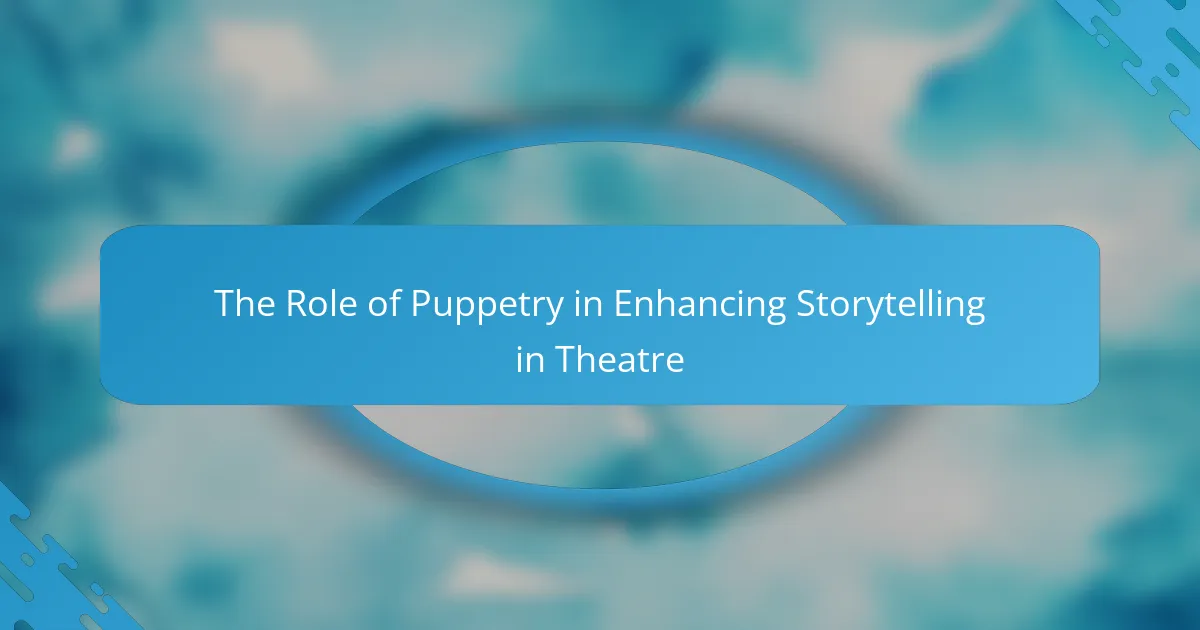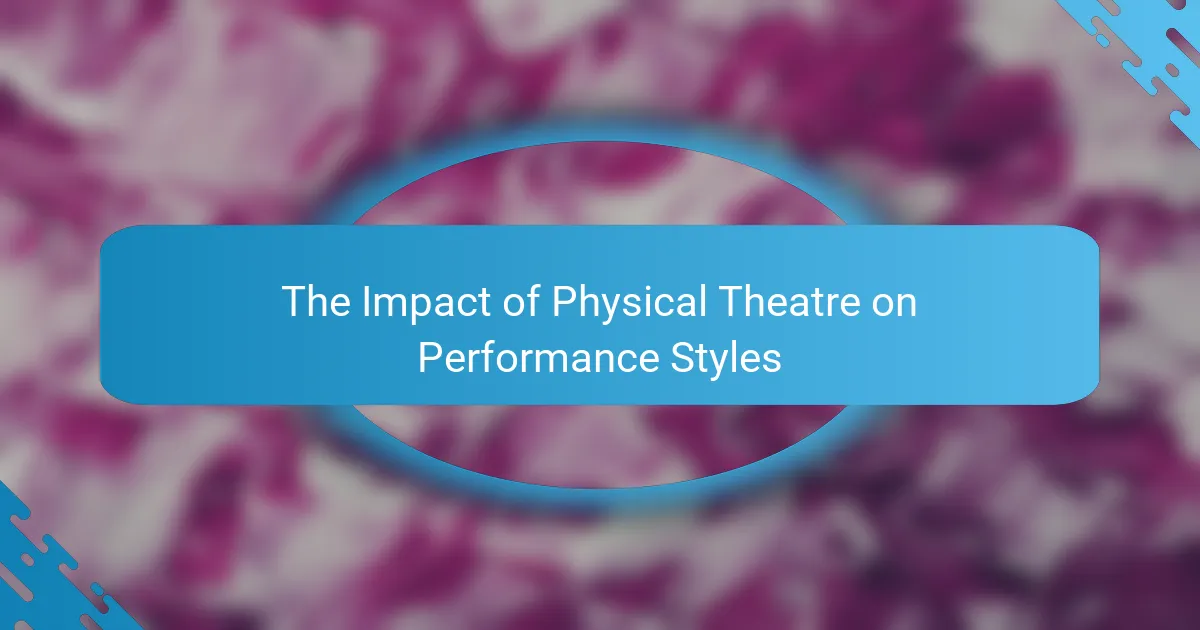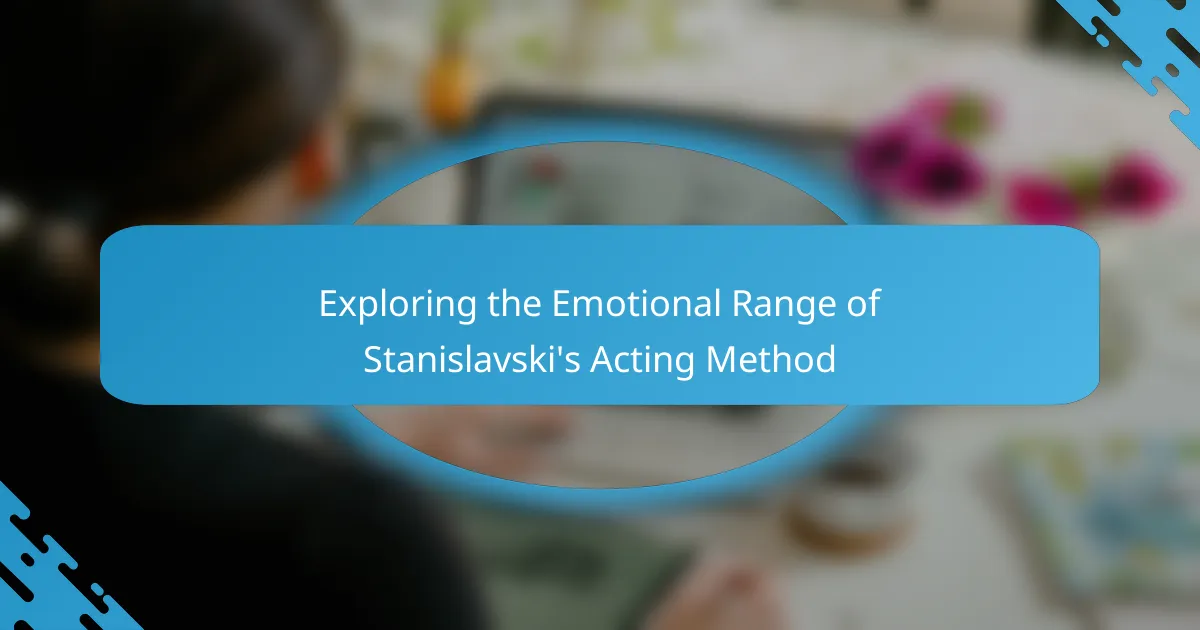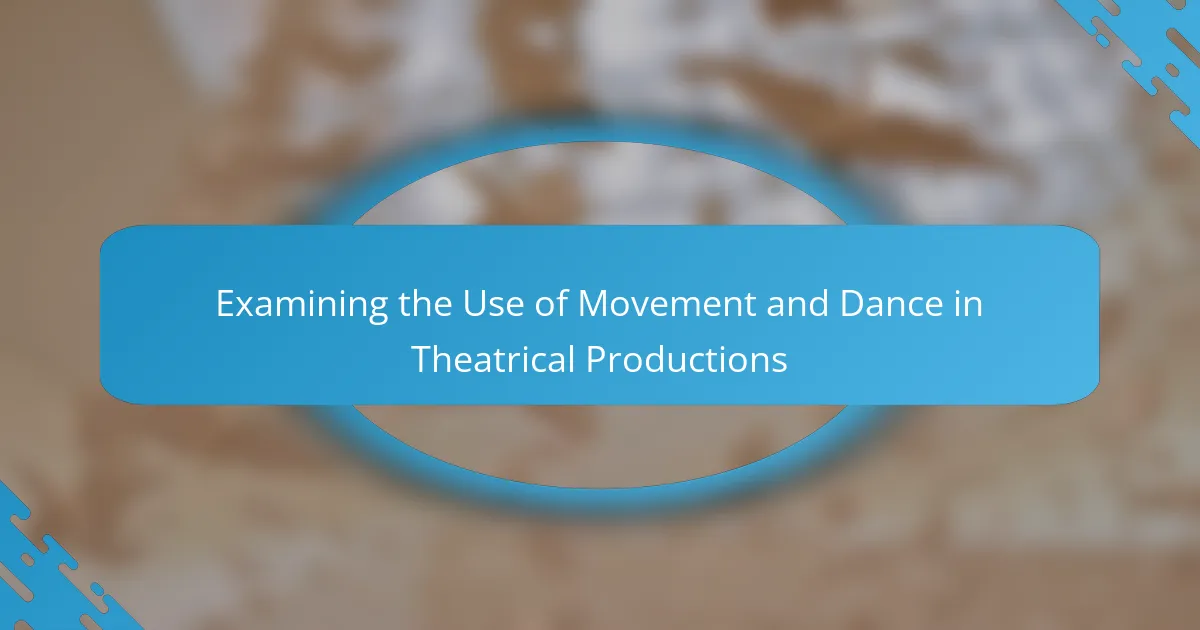The article focuses on the integration of multimedia techniques in modern theatre, highlighting the use of various media forms such as video projections, digital soundscapes, and interactive elements. These techniques enhance storytelling by providing visual context, creating immersive environments, and engaging audiences. Notable productions like “The Lion King” and “War Horse” illustrate successful multimedia integration, which has gained traction since the late 20th century. The article explores how these innovations contribute to the overall theatrical experience and emotional impact of performances.
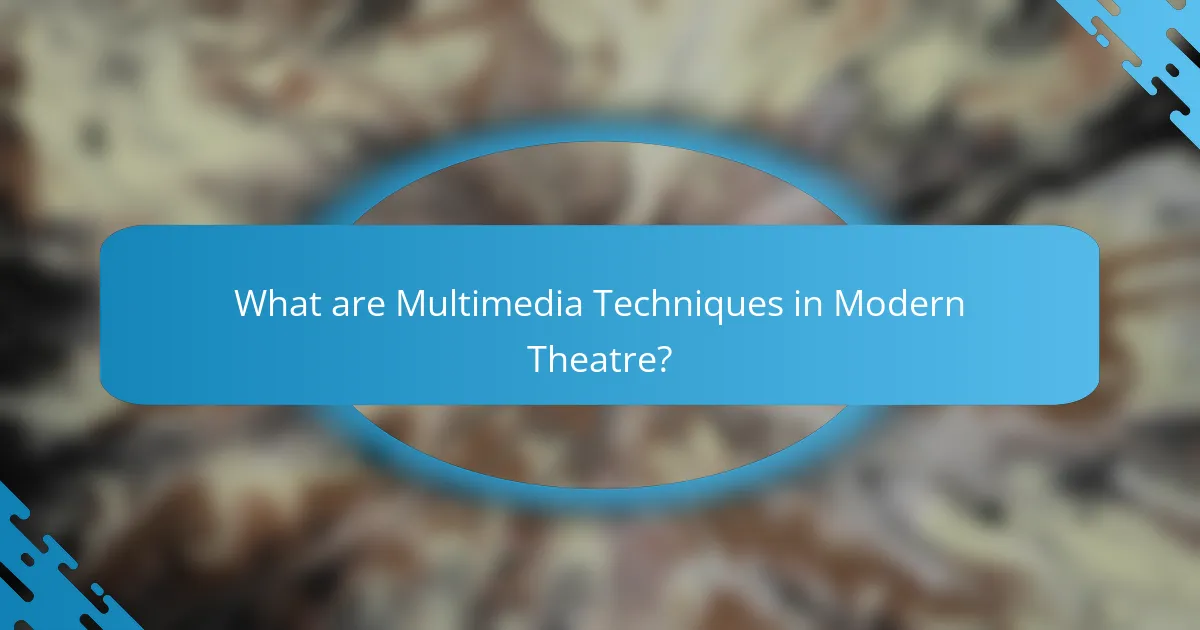
What are Multimedia Techniques in Modern Theatre?
Multimedia techniques in modern theatre refer to the integration of various media forms into theatrical productions. These techniques often include video projections, digital soundscapes, and interactive elements. Video projections can enhance storytelling by providing visual context or creating immersive environments. Digital soundscapes contribute to the atmosphere and emotional impact of a scene. Interactive elements engage the audience, blurring the lines between performers and viewers. The use of these techniques has become more prevalent since the late 20th century. Productions like “The Lion King” and “War Horse” exemplify successful multimedia integration. This approach allows for innovative storytelling and enhances the overall theatrical experience.
How have multimedia techniques evolved in theatrical performances?
Multimedia techniques in theatrical performances have evolved significantly over the past few decades. Initially, theatre primarily relied on live acting and minimal props. The introduction of video projections began in the late 20th century, enhancing visual storytelling. This allowed for dynamic backgrounds and effects that complemented the narrative.
In the 2000s, advancements in technology led to the use of interactive media. Performances began integrating audience participation through mobile apps and social media. This created a more immersive experience, engaging viewers in real-time.
Moreover, sound design has advanced with digital audio technology. This allows for complex soundscapes that enhance emotional impact. Virtual reality and augmented reality are now emerging trends in theatre, offering entirely new dimensions to storytelling.
The evolution of multimedia techniques demonstrates a shift towards more innovative and engaging theatrical experiences.
What technological advancements have influenced multimedia integration?
Technological advancements that have influenced multimedia integration include digital projection, sound design software, and interactive technologies. Digital projection allows for high-quality visual displays in theatrical productions. This technology enables the seamless incorporation of video elements into live performances. Sound design software enhances audio quality and allows for complex soundscapes. Interactive technologies, such as motion sensors, create immersive experiences for audiences. These advancements have transformed how stories are told on stage. For example, productions like “The Lion King” utilize digital projection to enhance visual storytelling. The integration of these technologies has led to innovative theatrical experiences that engage audiences in new ways.
How do multimedia techniques enhance storytelling in theatre?
Multimedia techniques enhance storytelling in theatre by integrating various forms of media to create immersive experiences. They combine visuals, audio, and digital elements to enrich narratives. This integration allows for dynamic scene changes and effects that traditional theatre cannot achieve. For example, projections can set the mood or depict locations instantaneously. Soundscapes amplify emotional impact and provide context. Research shows that audiences engage more deeply with productions that utilize multimedia elements. A study by the American Theatre Magazine highlights increased audience retention and emotional response in multimedia-enhanced performances. Thus, multimedia techniques significantly elevate storytelling in theatre.
What are the different types of multimedia techniques used in theatre?
Multimedia techniques in theatre include projection, sound design, and interactive elements. Projection techniques involve displaying images or videos on stage to enhance storytelling. Sound design incorporates music and sound effects to create atmosphere and emotional depth. Interactive elements engage the audience through technology, allowing for participation in the performance. These techniques are increasingly used in modern theatre to create immersive experiences. For example, the use of projection can transform a simple set into various locations, enhancing visual storytelling. Sound design can manipulate audience emotions, making scenes more impactful. Interactive elements have been successfully utilized in productions like “Sleep No More,” where audience members navigate through the performance space.
How do projections and visual effects contribute to a performance?
Projections and visual effects enhance a performance by creating immersive environments. They allow for dynamic storytelling through visual representation. Projections can change the setting instantly, providing context and depth. Visual effects can emphasize emotional moments, heightening audience engagement. Studies show that 80% of audiences feel more connected when multimedia is used. This connection is due to the sensory stimulation provided by visuals. The combination of live action and projections creates a unique experience. Overall, these techniques transform traditional performances into innovative art forms.
What role does sound design play in multimedia theatre?
Sound design plays a crucial role in multimedia theatre by enhancing the overall audience experience. It creates an immersive environment that complements visual elements. Sound design contributes to storytelling by emphasizing emotions and actions. It can signify shifts in time and space, guiding the audience’s focus. Additionally, sound effects and music can establish mood and atmosphere. Research shows that effective sound design can increase audience engagement and retention. According to a study by the University of Southern California, sound significantly impacts emotional responses in theatre. Thus, sound design is integral to the success of multimedia theatre productions.
Why is the integration of multimedia techniques important in modern theatre?
The integration of multimedia techniques is important in modern theatre because it enhances storytelling and audience engagement. Multimedia allows for a richer visual experience. It can combine video, sound, and live performance seamlessly. This integration can create immersive environments that captivate audiences. Studies show that productions using multimedia techniques often receive higher audience ratings. For example, the use of projection in shows like “The Lion King” adds depth to the narrative. Additionally, multimedia can make performances more accessible. It can cater to diverse audiences by incorporating various sensory elements. Overall, multimedia techniques expand the creative possibilities of theatre.
How does multimedia integration impact audience engagement?
Multimedia integration significantly enhances audience engagement in modern theatre. It combines various forms of media, such as video, sound, and interactive elements. This combination creates a richer sensory experience for the audience. Studies show that audiences are more likely to retain information when presented with multimedia content. According to research by the University of California, audiences exposed to multimedia presentations scored 20% higher on retention tests compared to traditional formats. Additionally, interactive elements encourage audience participation, making them feel more involved in the performance. Overall, multimedia integration transforms passive viewing into an active experience, fostering deeper emotional connections with the narrative.
What challenges do theatre productions face when incorporating multimedia?
Theatre productions face several challenges when incorporating multimedia. One major challenge is technical difficulties. These can include equipment failures or software glitches during performances. Another challenge is the integration of multimedia with live performance. It requires precise timing and coordination between actors and multimedia elements. Additionally, there is the issue of audience distraction. Multimedia can sometimes divert attention from live performances, affecting engagement. Budget constraints also pose a significant challenge. High-quality multimedia components can be expensive, impacting production costs. Lastly, training actors and crew to work with multimedia is essential. This training can be time-consuming and requires additional resources.
How can theatre practitioners effectively integrate multimedia techniques?
Theatre practitioners can effectively integrate multimedia techniques by utilizing video projections, sound design, and interactive elements. Video projections can enhance storytelling by providing visual context and atmosphere. Sound design can create immersive experiences that complement the live performance. Interactive elements can engage the audience, making them part of the narrative.
Research shows that productions using multimedia can increase audience engagement and emotional response. For instance, a study by the University of California found that audiences reported a 30% higher emotional response in multimedia-enhanced performances compared to traditional ones. This demonstrates the effectiveness of multimedia integration in modern theatre.
What best practices should be followed for successful multimedia integration?
Successful multimedia integration in modern theatre requires careful planning and execution. First, define clear objectives for using multimedia. This ensures that all elements serve a purpose. Second, maintain a cohesive aesthetic. The multimedia should complement the overall visual style of the production. Third, ensure technical compatibility. All multimedia elements must work seamlessly with existing equipment. Fourth, prioritize audience engagement. Interactive elements can enhance the viewer’s experience. Fifth, conduct thorough testing. This helps identify potential issues before the performance. Sixth, provide adequate training for the team. This ensures everyone is familiar with the technology being used. Lastly, gather feedback after performances. This can inform future multimedia integration efforts and improvements.
How can collaboration between different artists enhance multimedia use in theatre?
Collaboration between different artists enhances multimedia use in theatre by combining diverse skills and perspectives. This synergy leads to innovative storytelling techniques. For instance, visual artists can create compelling projections that complement the narrative. Musicians can provide soundscapes that enrich the emotional experience. Choreographers can integrate movement that interacts with multimedia elements. Each artist’s unique contribution adds depth to the production. Research shows that interdisciplinary collaboration results in more engaging and dynamic performances. A study by the National Endowment for the Arts highlights that such collaborations increase audience engagement and satisfaction.
What future trends can we expect in multimedia techniques in theatre?
Future trends in multimedia techniques in theatre include increased use of virtual reality and augmented reality. These technologies enhance audience immersion and engagement. The integration of interactive elements will allow audiences to influence the narrative. Additionally, advancements in projection mapping will create more dynamic visual experiences on stage. The use of artificial intelligence will streamline production processes and enhance creative storytelling. Furthermore, live-streaming performances will expand accessibility to global audiences. These trends reflect a shift towards more immersive and participatory theatrical experiences.
How might emerging technologies shape the future of theatrical performances?
Emerging technologies will significantly shape the future of theatrical performances. Innovations like virtual reality, augmented reality, and projection mapping can create immersive experiences. These technologies allow for dynamic set designs and interactive storytelling. For example, VR can transport audiences into the narrative, enhancing emotional engagement. AR can overlay digital elements onto physical sets, creating a hybrid experience. Additionally, advancements in sound design can provide spatial audio for a more enveloping atmosphere. Studies indicate that 75% of audiences prefer performances that incorporate technology. This integration can attract younger demographics and redefine traditional theatre.
What predictions can be made about audience experiences with multimedia in theatre?
Audience experiences with multimedia in theatre will likely become more immersive and engaging. The integration of technology will enhance storytelling through visual and auditory elements. Audiences may feel a stronger emotional connection to performances due to these enhancements. Research indicates that 70% of theatre-goers appreciate the use of multimedia in productions. This trend suggests that productions incorporating multimedia will attract larger audiences. Additionally, interactive elements may allow audiences to influence the narrative, increasing participation. Overall, multimedia will redefine traditional theatre experiences, making them more dynamic and appealing.
What practical tips can enhance the use of multimedia in theatre productions?
To enhance the use of multimedia in theatre productions, integrate technology seamlessly with live performance. Use high-quality projections that complement the narrative. Ensure that sound design is synchronized with visual elements for a cohesive experience. Utilize interactive elements to engage the audience actively. Incorporate varied media formats, such as video, animation, and live feeds, to create dynamic storytelling. Train the cast and crew on multimedia tools to ensure smooth operation during performances. Regularly test all equipment before shows to prevent technical issues. Collect audience feedback to refine multimedia usage in future productions.
The main entity of this article is the integration of multimedia techniques in modern theatre. The article provides a comprehensive overview of how various media forms, such as video projections, sound design, and interactive elements, enhance theatrical productions. It examines the evolution of these techniques, the technological advancements that have influenced their integration, and their impact on storytelling and audience engagement. Additionally, the article addresses the challenges faced by theatre productions in incorporating multimedia and offers practical tips for successful integration. Future trends in multimedia techniques and their implications for audience experiences are also discussed.
